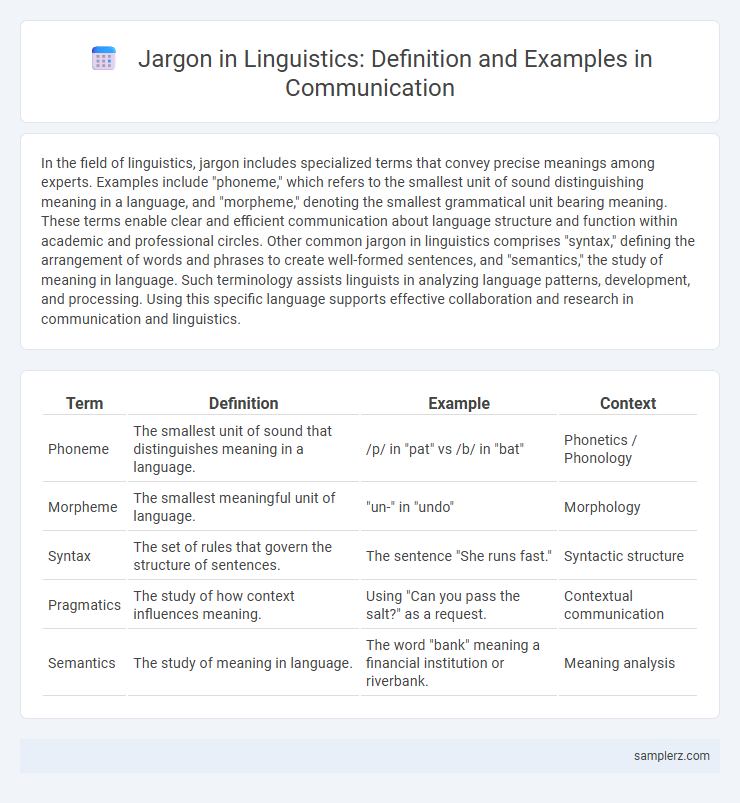In the field of linguistics, jargon includes specialized terms that convey precise meanings among experts. Examples include "phoneme," which refers to the smallest unit of sound distinguishing meaning in a language, and "morpheme," denoting the smallest grammatical unit bearing meaning. These terms enable clear and efficient communication about language structure and function within academic and professional circles. Other common jargon in linguistics comprises "syntax," defining the arrangement of words and phrases to create well-formed sentences, and "semantics," the study of meaning in language. Such terminology assists linguists in analyzing language patterns, development, and processing. Using this specific language supports effective collaboration and research in communication and linguistics.
Table of Comparison
| Term | Definition | Example | Context |
|---|---|---|---|
| Phoneme | The smallest unit of sound that distinguishes meaning in a language. | /p/ in "pat" vs /b/ in "bat" | Phonetics / Phonology |
| Morpheme | The smallest meaningful unit of language. | "un-" in "undo" | Morphology |
| Syntax | The set of rules that govern the structure of sentences. | The sentence "She runs fast." | Syntactic structure |
| Pragmatics | The study of how context influences meaning. | Using "Can you pass the salt?" as a request. | Contextual communication |
| Semantics | The study of meaning in language. | The word "bank" meaning a financial institution or riverbank. | Meaning analysis |
Defining Jargon in Linguistics
In linguistics, jargon refers to specialized terminology used by experts within a particular field to convey precise meanings efficiently. Examples include phoneme, morpheme, and syntax, which describe fundamental aspects of language structure. This technical language facilitates clear communication among linguists but often remains inaccessible to non-specialists.
Importance of Jargon in Language Studies
Jargon in linguistics, such as phoneme, morpheme, and syntax, serves as specialized terminology that enables precise and efficient communication among language scholars. The importance of jargon lies in its ability to standardize complex concepts, facilitating clearer analysis and discussion of language structures and phenomena. Understanding and utilizing linguistic jargon enhances accuracy in research, education, and cross-disciplinary collaboration within language studies.
Common Linguistics Jargon and Their Meanings
Phoneme refers to the smallest unit of sound that can distinguish meaning in a language, such as /p/ and /b/ in "pat" and "bat." Morphology is the study of word formation and structure, analyzing how morphemes like prefixes, roots, and suffixes combine to create meaning. Syntax examines sentence structure, focusing on the rules that govern word order and phrase arrangement to convey clear communication.
Syntax-Specific Jargon Examples
Syntax-specific jargon in linguistics includes terms like "movement," "agreement," and "head-complement structure," which describe the relationships and order of elements within sentences. Concepts such as "X-bar theory" and "theta roles" help define hierarchical phrase structures and argument functions in syntactic analysis. These specialized terms enable precise discussion of sentence formation and grammatical patterns in human language.
Phonetics and Phonology: Key Terms Used
In linguistics, phonetics and phonology employ specialized jargon such as "phoneme," referring to the smallest unit of sound that can distinguish meaning, and "allophone," which denotes variant forms of a phoneme in specific contexts. Terms like "articulation," describing how speech sounds are produced by the vocal tract, and "intonation," the variation of pitch in spoken language, are crucial for analyzing sound patterns. Understanding this jargon enables precise communication about speech sounds and their functional roles in language systems.
Pragmatics: Specialized Vocabulary
Pragmatics in linguistics includes specialized vocabulary such as "speech acts," "deixis," and "implicature," which describe how meaning is conveyed beyond literal words. Terms like "presupposition" and "contextualization cues" are crucial for analyzing how speakers imply and interpret meanings in conversation. Understanding these pragmatic concepts enhances effective communication by decoding implied intentions and social context.
Jargon in Sociolinguistics Research
Jargon in sociolinguistics research includes terms like "code-switching," referring to alternating between languages or dialects in conversation, and "speech community," which denotes a group sharing linguistic norms. These specialized terms facilitate precise analysis of language use in social contexts. Understanding such jargon enhances the clarity and depth of sociolinguistic studies.
Morphology: Technical Terms Explained
In linguistics, morphology involves specialized jargon such as "morpheme," the smallest unit of meaning, and "allomorph," which describes variant forms of a morpheme. Terms like "inflection," indicating modifications to a word for grammatical purposes, and "derivation," referring to the creation of new words from existing ones, are fundamental in morphological analysis. Mastery of this technical vocabulary is essential for understanding the structure and formation of words in human language.
Semantics: Language of Meaning
In semantics, jargon often includes terms like "polysemy," which refers to a single word having multiple related meanings, and "homonymy," where words share spelling or pronunciation but have unrelated meanings. Another common term is "pragmatics," the study of how context influences meaning beyond the literal interpretation of words. These specialized terms enable linguists to discuss the nuances of meaning and how language conveys different concepts in various contexts.
Impact of Linguistic Jargon on Communication
Linguistic jargon, such as "phoneme," "morpheme," and "syntax," often creates barriers in communication by alienating non-specialists and reducing message clarity. The excessive use of specialized terms can hinder effective knowledge transfer and limit audience engagement, especially in interdisciplinary or public contexts. Understanding and minimizing jargon enhances mutual comprehension and promotes clearer, more inclusive communication.

example of jargon in linguistics Infographic
 samplerz.com
samplerz.com